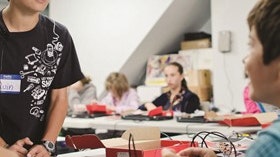Homepage
•
Learning Library
•
Blog
•
What if every kid could learn through tinkering?
Expand breadcrumbs
Expand breadcrumbs
- Learning Library
- Blog
- What if every kid could learn through tinkering?
- Homepage
- •
- Learning Library
- •
- Blog
- •
- What if every kid could learn through tinkering?
What if every kid could learn through tinkering?
By Sharleen Nelson
June 9, 2014








